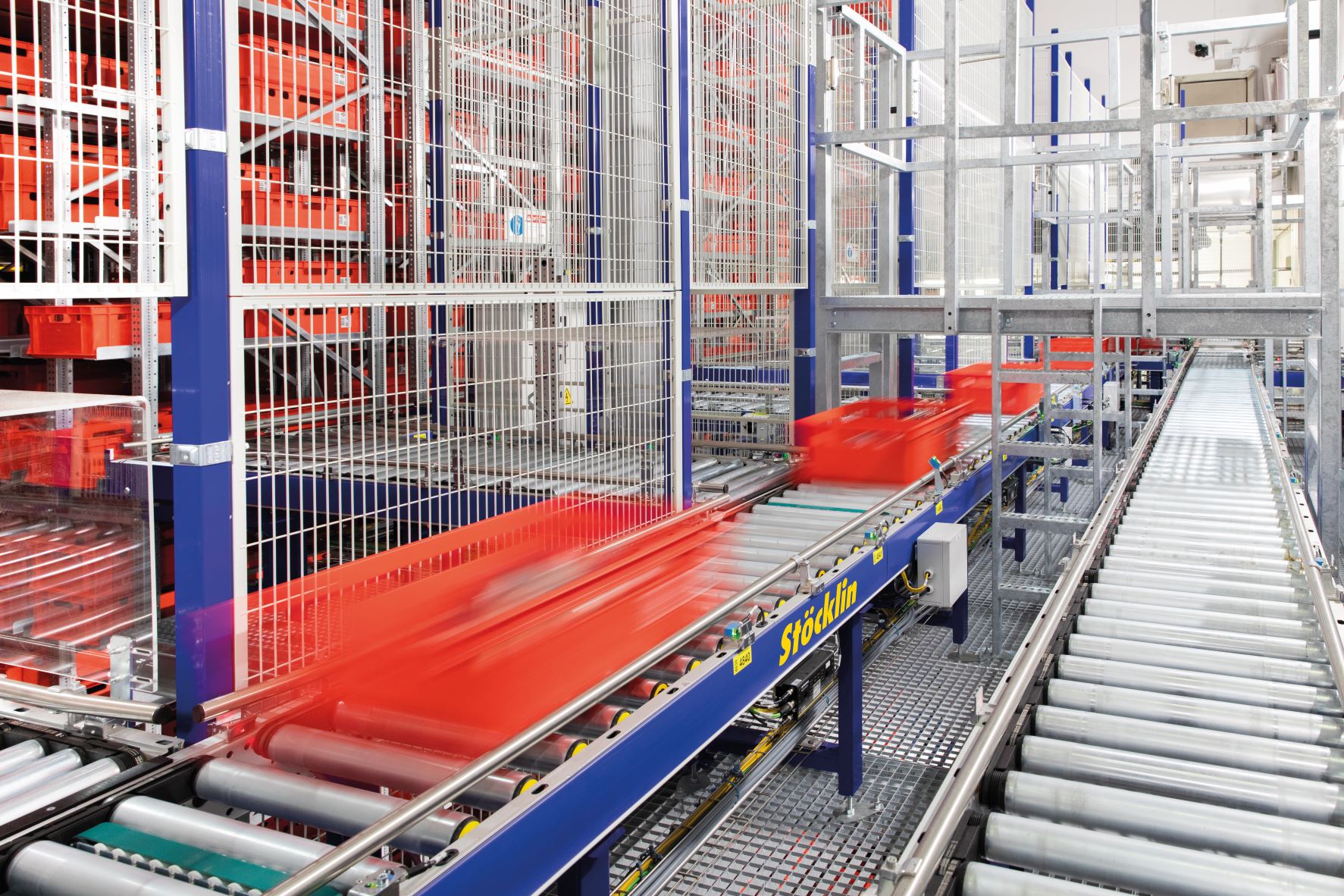
Maximum efficiency, performance and system availability – those were the requirements Bell Switzerland AG [Bell] had for its automated high-bay warehouse in Oensingen (SUI). Bell is one of the leading processors of meat and convenience products in Europe and market leader in Switzerland. Based on those parameters, Stöcklin Logistik AG successfully expanded and upgraded the system previously in place. In total, three new AS/RS cranes were installed and a further four outdated cranes were replaced with state- of-the-art BOXer technology including new anti-sway software. Additionally, new conveyor systems with integrated container stackers were installed.
The project is part of a large-scale investment program for the Oensingen site in Solothurn. With this program, the Bell is increasing its performance and capacity for meat products processing and storage. Among other things, the focus is on increased automation of production processes and more efficient fresh produce logistics. Respectively, work initially started on the expansion and modernization of the high-bay warehouse that has been in operation since 2005, where
already portioned fresh meat products are temporarily stored until delivery.
Aiming high – oscillation free due to proven technologies
“Continuous growth had brought the existing warehouse close to its performance limits” reports Stöcklin project manager Remo Cueni. “Bell therefore took the option of expanding the existing high-bay warehouse for its range of fresh products. At the same time, we recognized that a retrofit would not provide the desired performance for the four storage and retrieval machines that had been in place since the beginning. Instead, a complete replacement was necessary to achieve the desired system availability.”
Given the circumstances, both the modularly designed, energy-efficient and high-performance BOXer container storage cranes, as well as the newly developed anti-sway software, convinced Bell that it was on the right path. Further, the anti-sway software prevents mast vibrations on the stacker cranes, which are around 65 ft tall, to maximize performance and eliminates the need for anti-sway drive/feature that the old cranes previously were equipped with. “The time saved
through the application of the anti-sway software positively impacts the commissioning of the system. The entire structure at Bell was commissioned over the course of three days, including the SAT” Cueni emphasizes. He lists other benefits as optimized performance, less wear and tear, lower overall acquisition and reduced maintenance costs.
Connecting container storage cranes to WMS
The expansion included the installation of a new three-aisle, double-deep racking system, with storage capacities for 29,232 containers in approximately 65 ft long aisles. The crane are equipped with a support mast, a camera-monitored load handling device with 2 x 110lbs payload as well as the anti-sway software and the ability to back-feed power into the grid. At peak times, each crane achieves 65 double cycles per hour. An interface software links the system to the enterprise resource planning (ERP) system or warehouse management system (WMS) of CSB-Systems AG, thus ensuring a seamless communication and information flow. In addition, the device status can be called up at any time via a stand-alone visualization/Dashboard.
Before the analog programmed BOXer D1 stacker cranes, which are around the same height as the new cranes (65 ft), were installed in the existing warehouse, new rails were laid out after the existing third-party stacker cranes had been dismantled. To maintain production and ensure high and continuous availability, the replacement of the cranes was carried out in stages.
A high-performance conveyor system to connect production across two floors
The expansion and connection of the container conveyor system, which connects the fully automated high-bay warehouse with both the cutting plant and outbound area, required a lot of know-how and experience. One carousel was added on both the ground floor and upper floor to connect with the existing conveyor system. The carousel on the upper floor has two container stackers for storage and one container stacker for retrieval.
On straight sections and turns alike, the conveyor system allows for a throughput of around 1,200 totes and around 1,000 load carriers per hour. Peak values of 410 are achieved when totes are stacked. All E2 containers, with dimensions of 600x400x200 mm, receive two RFID tags, that are printed with a barcode and the container number for traceability. A link between transponder and container numbers is established through the WMS. In the case of stacked containers, the lower of the two is always read, and the link of those stacked containers is also stored in the WMS.
Meeting growing demand in an agile and reliable manner
For Bell, the modernization and expansion of the existing high-bay warehouse is an important step toward securing productivity and competitiveness in the Swiss market. Further strategic optimization and expansion measures in the production and logistics environment will follow.
“In addition to high performance, maximum plant availability was particularly relevant for Bell,” says project manager Remo Cueni. “At Stöcklin Logistik, AG, we guarantee this through the high degree of in-house production of the proven, robustly designed products, which are manufactured at the Laufen production site with nothing less than Swiss precision.” Short response times are guaranteed and crucial in the event of a malfunction, with 24-hour availability 365 days a year. Bell is also relying on Stöcklin’s industry expertise, which is being validated once again in this project, to equip the new fresh and frozen food center in Oensingen with the latest in AS/RS technologies, scheduled to go live in March 2023.

Recent Comments